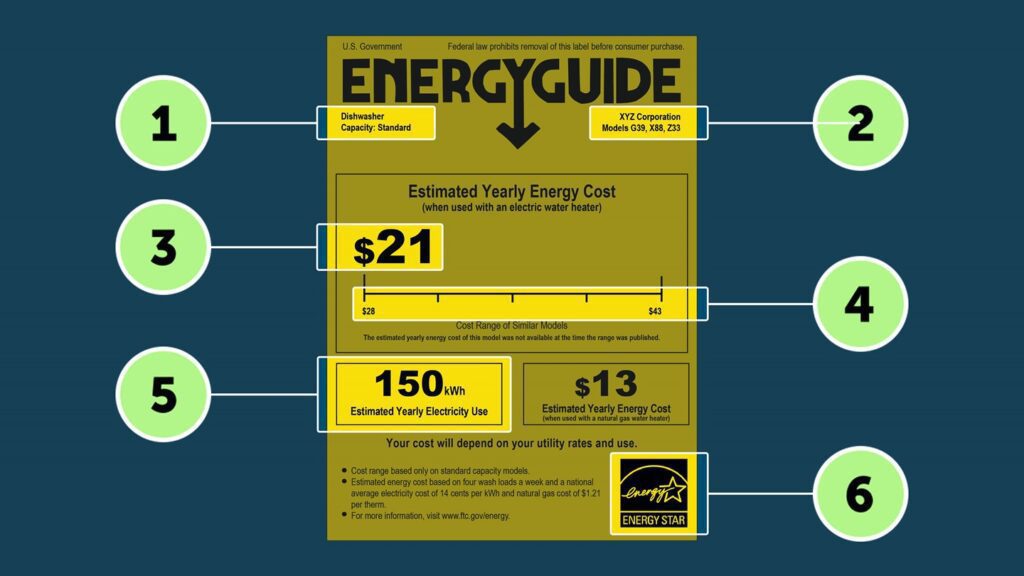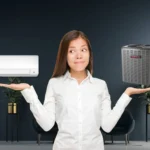If you’ve shopped for appliances recently, you’ve probably noticed the big yellow sticker on the side of the box. That’s the Energy Guide label, (not to be confused with the ENERGY STAR® logo). It appears on all sorts of appliances, from refrigerators and ovens to AC units and televisions.
What is the Energy Guide label?
The Energy Guide label is a federal standard that gives transparency to consumers about how much it costs to run the appliance. The idea is simple: give shoppers the information they need to choose which appliance is right for them. Even if an appliance costs more up front, it might cost less to operate because it’s more energy efficient. Likewise, a cheaper appliance might cost you more in the long run because it’s more expensive to run every year.

There are six key elements of the Energy Guide label:
- Key features. If you’re comparing models of the same type of appliance (say, window AC units), the key features should match. Apples to apples.
- Make, model, and size of the appliance.
- Estimated annual operating cost. This can be a little misleading, because the estimated annual operating cost is calculated based on the nationwide average cost of electricity. If you live somewhere with lower electricity rates, your annual operating cost will be lower. Also, the more you use the appliance, the more electricity you consume, and the more money you’ll spend every year.
- Range of operating costs for similar models. This is a scale showing the range of prices for appliances with the same key features.
- Estimated annual electrical usage. This is calculated based on the average electrical usage, so your usage will vary depending on your household’s needs. For example, if you need to do a load of laundry every day, your electrical usage will be higher than someone who does a load of laundry once a week. This impacts the annual operating cost, too.
- ENERGY STAR logo. If the appliance meets the Environmental Protection Agency’s voluntary standards for high efficiency, you’ll see the ENERGY STAR logo on the yellow Energy Guide label. Products that earn the ENERGY STAR label are independently certified to meet strict energy efficiency standards, so you can be sure your appliance is more efficient than average.
What’s the difference between the Energy Guide label and ENERGY STAR logo?
The Federal Trade Commission (FTC) created the Energy Guide label to protect consumers. It’s like the nutrition labels you see on food. Meanwhile, ENERGY STAR is a certification created by the Environmental Protection Agency (EPA). Appliances that are more efficient than the federal standard and meet the EPA’s higher, voluntary standards can get the ENERGY STAR designation. Often, you’ll see the ENERGY STAR logo on the bottom right corner of the Energy Guide label. The most efficient appliances of all are called ENERY STAR Most Efficient.
Choose the right appliance for you
Understanding the Energy Guide label can empower you to shop smartly for your next appliance. The label is universal, so no matter where you plan to buy the appliance, you can rest assured that you’re getting consistent information. Every household is different, and the Energy Guide label can help you find the right appliance for your unique needs and priorities.
When considering new HVAC systems or upgrading existing ones, understanding ENERGY STAR ratings is crucial. Established by the U.S. Environmental Protection Agency (EPA) in 1992, the ENERGY STAR program identifies and promotes energy-efficient products, helping consumers reduce energy consumption and greenhouse gas emissions. In 2025, ENERGY STAR continues to set stringent standards for HVAC systems, ensuring that certified products deliver superior efficiency and performance.
Upgrading to an ENERGY STAR-certified HVAC system can significantly reduce energy usage and lower utility bills. ENERGY STAR-rated appliances, including HVAC systems, are generally 20% more energy-efficient than non-certified models. This efficiency not only lowers electricity costs but also reduces the strain on HVAC components, extending system lifespan and decreasing maintenance expenses.
HVAC systems are rated using the Seasonal Energy Efficiency Ratio (SEER), which measures cooling efficiency. As of 2025, ENERGY STAR-certified central air conditioning systems must meet a minimum SEER2 rating of 14.3 in northern states and 15.2 in southern states. Additionally, these systems must have an Energy Efficiency Ratio (EER) of at least 11.0 for single models and 12.0 for split systems to qualify for certification. Investing in a high-quality ENERGY STAR HVAC system is a proven strategy for long-term energy savings while maintaining year-round comfort.
SEER Ratings and ENERGY STAR Certification
HVAC systems are evaluated using the Seasonal Energy Efficiency Ratio (SEER), which measures cooling efficiency. As of 2025, to earn the ENERGY STAR label, central air conditioners in the southern U.S. must have a SEER2 rating of at least 15.2, while those in the northern U.S. require a minimum SEER2 of 14.3. Higher SEER2 ratings indicate greater energy efficiency.
How ENERGY STAR HVAC Systems Are Certified
For an HVAC system to earn the ENERGY STAR label, it must meet strict energy efficiency guidelines set by the U.S. Environmental Protection Agency (EPA). These criteria ensure that ENERGY STAR-certified products offer substantial energy savings without compromising performance. The key requirements include:
- Demonstrated Energy Savings: Products must provide measurable energy efficiency improvements that benefit consumers nationwide.
- Performance & Features: Certified models must meet or exceed industry standards for reliability, durability, and user satisfaction.
- Cost-Effective Efficiency: Even if an ENERGY STAR system has a higher upfront cost, it must deliver long-term savings on utility bills compared to non-certified alternatives.
- Multiple Technology Options: ENERGY STAR certification is available across various HVAC technologies from different manufacturers, ensuring a range of choices for consumers.
- Independent Testing & Verification: Products must undergo third-party testing to validate energy performance and efficiency claims.
- Clear Labeling for Consumers: ENERGY STAR-certified HVAC systems feature easy-to-recognize labels, helping homeowners quickly identify energy-efficient options.
- Regular EPA Updates: The EPA periodically revises certification criteria to reflect advances in energy efficiency and evolving environmental standards.
These rigorous requirements ensure that ENERGY STAR HVAC systems provide tangible energy and cost savings, making them a smart investment for homeowners looking to reduce energy consumption and environmental impact.

JK HVAC We install, repair and service all brands of air conditioners! Including air conditioner cleaning, dryer vent cleaning, furnace repair.
📍 Serving all of New York City: Manhattan, Brooklyn, Staten Island, Queens…









